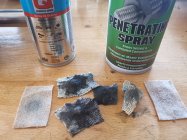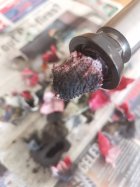I became a crowd follower, while claiming not to be.
On the subject of bronze brushes versus nylon.
I've been getting several strange results trying to figure out a groove diameter. After trying several methods, and looking at things carefully with a borescope, I realised the measurements are skewed by carbon buildup in the grooves towards the muzzle.
The rifle is fairly new, 300 rounds approximately so far. I've always used nylon brushes to clean it. I dip the end of a brush in the particular solvent, then brush the barrel with ten strokes. seperate brushes for each solvent. My cleaning involves a first pass with Ballistol, patched out, and a second with Boretech Eliminator. This process is repeated three times, and the Boretech sits for about 10 minutes each time before being patched out. I sometimes use Forrest bore cleaning foam before the first pass of Ballistol, and leave it in for an hour before continuing,
When the last patch is clean, I run one final patch with balistol, and I put the rifle away. I thought I was doing a good job of cleaning.
The first thing I did when I realised what I was dealing with was a twenty strokes scrub with Eliminator, and let it sit for an hour. Two patches later it was 'clean'. Borescope called bull-crap. Eliminator, brush, leave overnight. Next day, first patch was clean. I went through other solvents in my box. Butch's Bore Shine, Shooter's Choice and a foul smelling orange liquid in a bottle with no label. Nothing better came of it. I used JB Bore paste. All I got on the patches was JB Bore Paste. Same with Iosso. Then I went to Google.
I found mention of using a penetrating oil and a brush.
So I got myself a tin of Q5. Applied the Q5, brushed with the nylon brush, a bit of black on the first patch, third patch clean. Borescope still calling bull-crap.
I had one old bronze brush. It was the right size for the bore. Liberal squirt of Q5, wait one minute, bronze brush - jackpot. My barrel vomited black oil. I've been repeating this every few hours for two days, and the borescope is finally agreeing that cleaning is actually taking place.
300 rounds sounds like a low round count to have such a hard carbon fouling problem, but that represents close to 32,000 grains of powder. Enough, I think, to build up to this extent.
Nylon brushes do not clean anything. All a nylon brush does is spread the solvent around the bore nicely for you, and solvent is great for dissolving copper. All I manged to do with nylon brushes and patches was remove excess, then polish the residue into place in the barrel.
Whoever invented the nylon brush was not a rifle shooter, and never had to get a rifle barrel clean with one.
This is not a comment on the efficiency of any product named here. I just described what I did, and with what. It is entirely possible I was using the product the wrong way, not enough of, or without a key additive to go with it.
I've ordered bronze brushes for all my target rifles. I understand a bronze brush eventually wears, but that's why you can buy packs of 10.
The nylon brushes are only good for spreading copper solvent in the bore.












